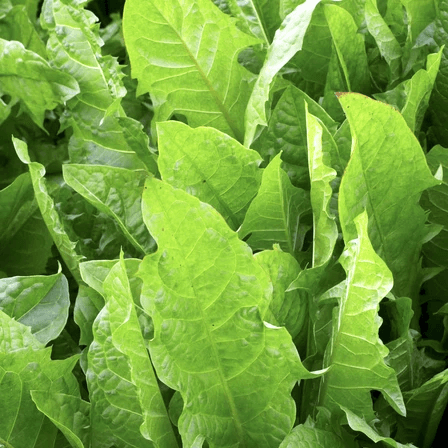- Perennial Vegetables
- >
- Perennial Vegetable Seeds
- >
- True Dandelion Greens
True Dandelion Greens
SKU:
$3.30
$3.30
Unavailable
per item
A true dandelion, and truly perennial, not the chicory known as "Italian Dandelion.". This strain has been selected for larger, juicier leaves. Once you have them, they can be a reliable source of greens year after year. The roots may be harvested for roasting to make a coffee-like drink. Dandelions have also been used for hundreds of years as a mild but reliable diuretic, liver tonic, and detoxifier. They are a quintessential medicinal food. Can be more challenging to start than annual vegetables, for details on starting and growing them, see below. 200 seeds
As with most perennials, the seed has dormancy mechanisms that make it take longer to sprout than annual vegetables. Fresh seeds sprout the most easily, when they are first shed by the plant. Those that have been dried for storage and put in a packet are "asleep" and need three things to wake them up: Rich, moist soil; fluctuating temperatures (with colder nights and warmer days); and light, which is the most important. Buried seeds won't sprout. Your best bet is to use pots, so the seeds won't be disturbed, but leave them out in the weather in spring. Use very rich soil, richer than normal for seed-starting--the seeds are wakened by nitrogen. (Ever wonder why dandelions grow so thickly where dogs visit?....) Tamp the moist soil and sprinkle the seeds thinly on top. Tamp in firmly, and barely cover. You should get sprouts in 3 weeks to a month. Transplant into a spot that is not going to be and has afternoon shade. Full sun will make the plants get bitter faster, make smaller leaves, and induce more flowers and reseeding, which may escape to unwanted spots.
Here is how to have a dandelion patch that is a reliable source of food, medicine, and beverages without irking either you or your neighbors:
1) Plant them in the shade. 2) Give them good garden soil and water. Stressed plants will be bitter and bolt to seed. 3) Harvest often. If you don't want to eat the leaves, cut them anyway and use them for mulch, "chop & drop" style. Or dry them for tea, feed to chickens, etc. 4) Cut the incipient flowers before the stalk lengthens. These are like little mini-artichokes, great in stir-fries, etc. Or compost them. But don't let the plant bloom. 5) As the summer goes on and the leaves seem bitter, put a flowerpot over the plant to blanch it for 3 weeks. This is a great addition to fall/winter meals.
Here is how to have a dandelion patch that is a reliable source of food, medicine, and beverages without irking either you or your neighbors:
1) Plant them in the shade. 2) Give them good garden soil and water. Stressed plants will be bitter and bolt to seed. 3) Harvest often. If you don't want to eat the leaves, cut them anyway and use them for mulch, "chop & drop" style. Or dry them for tea, feed to chickens, etc. 4) Cut the incipient flowers before the stalk lengthens. These are like little mini-artichokes, great in stir-fries, etc. Or compost them. But don't let the plant bloom. 5) As the summer goes on and the leaves seem bitter, put a flowerpot over the plant to blanch it for 3 weeks. This is a great addition to fall/winter meals.

